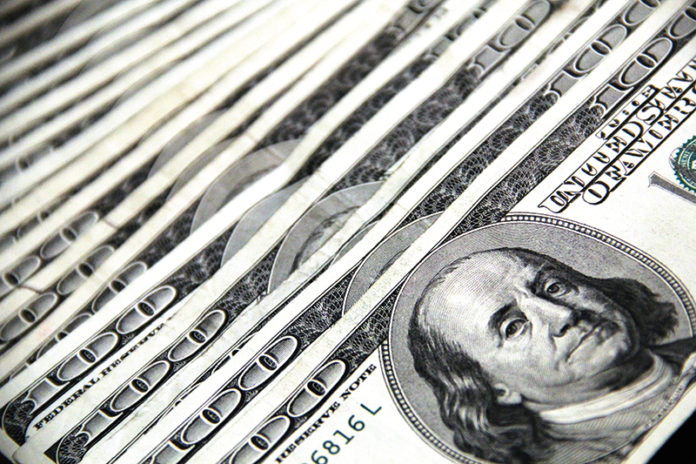Dolar – jedna z najpotężniejszych walut świata. Obecna w handlu międzynarodowym nawet tam, gdzie Stany Zjednoczone nie są stroną, służąca do rozliczania transakcji na rynku ropy naftowej, silny instrument polityki zagranicznej. USA zdają sobie z tego sprawę, wykorzystując dominującą pozycję swojej waluty do budowy gospodarczej potęgi i do walki w globalnej grze wpływów.
W 1944 roku w Bretton Woods w USA delegaci państw alianckich zdecydowali o utworzeniu międzynarodowego systemu walutowego opartego na utrzymywaniu stałych kursów wymiany walut na USD, który z kolei był wymienialny na złoto na żądanie. Dzięki tym decyzjom światowa pozycja dolara znacząco urosła. Po zniesieniu przez Nixona parytetu złota w 1971 roku, dolar stał się pieniądzem fiducjarnym – jego wartość ustalana była odtąd przez bank centralny w oparciu o kurs wymiany.
Aby nie stracić dominującej pozycji dolara, Stany Zjednoczone zdecydowały się na zawarcie porozumienia z Arabią Saudyjską w celu ujednolicenia cen ropy. Odtąd wszelkie transakcje sprzedaży ropy naftowej miały być dokonywane w dolarach. Tak narodził się system petrodolarów, który wygenerował sztuczny popyt na amerykańską walutę na całym świecie.
Narzędzie władzy
W efekcie dolar ma obecnie pozycję dominującej światowej waluty rezerwowej, z której korzysta wiele zagranicznych rządów. System petrodolarów zapewnił USA także inną, niemniej istotną przewagę – Stany Zjednoczone mogły odtąd utrzymywać stały deficyt w bilansie wymiany handlowej, zaciągając długi u zagranicznych podmiotów. W rezultacie są jedną z największych i najprężniej rozwijających się gospodarek świata, będąc jednocześnie najbardziej zadłużoną (23 biliony USD w 2019). Dzięki silnemu i stabilnemu dolarowi niektóre kraje także chętnie decydują się na USD jako swoją oficjalną walutę, co określa się mianem dolaryzacji (ang. dollarization).
Dominująca pozycja dolara to potężny instrument polityki zagranicznej, dający możliwość egzekucji przestrzegania sankcji gospodarczych wobec amerykańskich oponentów. Zarówno rodzime, jak i zagraniczne podmioty niechętnie robią interesy z adresatami sankcji ze względu na możliwe kary. BNP Paribas został na przykład skazany na 9 mld dolarów grzywny za naruszenie sankcji wobec Iranu, Kuby i Sudanu. Za podobne naruszenia inne podmioty (np. HSBC Holdings Plc, Standard Chartered Plc, Commerzbank AG, United Co. Rusal i Clearstream Banking SA) również musiały zapłacić wysokie grzywny. Jaskrawym przykładem był też spór z Iranem, gdy USA nałożyły sankcje na irańską gospodarkę, grożąc jednocześnie karami wszystkim, którzy kontynuowaliby handel z tym państwem w dolarach. Ta decyzja miała negatywny wpływ na partnerów handlowych Iranu, a więc przede wszystkim Chiny, Turcję, Koreę Płd., Indie i Niemcy.
Wpływ polityki zagranicznej na kurs dolara
Siłę zapewnia dolarowi system petrodolarów, jak również wykorzystywanie głównie tej waluty do transakcji w międzynarodowym handlu. Słabsza i niepewna sytuacja gospodarcza konkurentów spowodowana sankcjami (np. Iran, Rosja) powoduje odpływ pieniędzy do bezpiecznej amerykańskiej przystani. Widać to szczególnie w ostatnim czasie, gdy światowy lockdown i problemy innych gospodarek, spotęgowane dodatkowo wojną cenową na rynku paliw, pchnęły inwestorów w objęcia USD, powodując jego silne wzrosty. Na kurs amerykańskiej waluty ma też wpływ popularność osoby prezydenta USA. Gdy tzw. POTUS (ang. President of the United States) postrzegany jest jako silny organ wykonawczy, czego nie można odmówić Donaldowi Trumpowi, zachęca to inwestorów do lokowania środków w dolarze.
Trudno natomiast ocenić wpływ wojny handlowej między USA i Chinami. Kurs dolara w tym względzie będzie zależeć od wyników gospodarczych USA w skali globalnej (które do tej pory były solidne), działań Rezerwy Federalnej oraz polityki pieniężnej banków centralnych na całym świecie. Pewnym jest natomiast, że główni partnerzy handlowi USA – Chiny i Japonia – posiadający znaczną część długu amerykańskiego nie pozwolą na ostrą dewaluację dolara, która skutkowałaby utratą wartości ich własnych rezerw.
Czy czeka nas koniec dominacji dolara?
Mimo że rozwijający się sektor energetyczny coraz istotniej wpływa na wzrost PKB USA, duża różnorodność gospodarcza Ameryki zmniejsza zależność od tej branży. Poprzez dywersyfikację władze starają się zabezpieczyć przed możliwymi skutkami utraty dominującej pozycji dolara. A ta wydaje się coraz bardziej prawdopodobna. W ubiegłym roku Arabia Saudyjska zagroziła porzuceniem petrodolarów, jeśli Stany Zjednoczone będą kontynuować próby podporządkowania sobie państw OPEC poprzez forsowanie propozycji ustawy „No Oil Producing and Exporting Cartels Act”, która uzależniałaby działania krajów członkowskich kartelu od wymiaru sprawiedliwości USA. Z kolei Iran i Wenezuela podpisały kontrakty naftowe w swoich własnych walutach zamiast dolarów. W ostatnich latach Chiny wprowadziły kontrakty terminowe na ropę denominowane w juanach, natomiast Rosja zawarła szereg umów handlowych z Chinami i Iranem, które całkowicie pomijają USD. Europa także przejawia dążenia do alternatywnego systemu waluty rezerwowej, co w przyszłości może spowodować zastąpienie dolara przez euro, które jest jego głównym konkurentem. Mniejsze zużycie paliw kopalnych w wyniku postępującego, szczególnie w Europie, przejścia na źródła odnawialne może zmniejszyć zapotrzebowanie na dolara, choć zapewne nie spowoduje jego istotnej dewaluacji, póki świat nie znajdzie należytego substytutu.
Utrata dominującej pozycji przez dolara z pewnością znalazłaby odzwierciedlenie w spadku wpływów geopolitycznych i gospodarczych Stanów Zjednoczonych. Jednocześnie zmusiłaby USA do ograniczenia wydatków, a dodatkowo mogłaby uderzyć w do tej pory prężnie rozwijającą się amerykańską gospodarkę. Wygląda na to, że Amerykanie jednak muszą być na taki scenariusz przygotowani w czasach, gdy globalny układ sił staje się wielobiegunowy, a pozycja dolara, choć silna, nie jest już tak „nietykalna” jak kiedyś.
**
Jakub Łyjak

ukończył prawo na Uniwersytecie im. Adama Mickiewicza w Poznaniu oraz ekonomię na Uniwersytecie Ekonomicznym w Poznaniu. Studiował również Business Administration (Betriebswirtschaftslehre) na Westfälische Wilhelms-Universität w Münster. Doświadczenie zawodowe zdobywał w branży prawnej oraz organizacjach pozarządowych, m.in. Polish Entrepreneurship and Leadership Association oraz Center for American Studies.
The Warsaw Institute Foundation to pierwszy polski geopolityczny think tank w Stanach Zjednoczonych. Strategicznym celem tej organizacji jest wzmocnienie polskich interesów w USA przy jednoczesnym wspieraniu unikalnego sojuszu między dwoma narodami. Jej działalność koncentruje się na takich zagadnieniach jak geopolityka, porządek międzynarodowy, polityka historyczna, energetyka i bezpieczeństwo militarne. The Warsaw Institute Foundation została założona w 2018 roku i jest niezależną organizacją non-profit, inspirowaną bliźniaczą organizacją działającą w Polsce – Warsaw Institute.
The Warsaw Institute Foundation is Poland’s first geopolitical think tank in the United States. The strategic goal of this organisation is to bolster Polish interests in the U.S. while supporting the unique alliance between the two nations. Its activity focuses on such issues as geopolitics, international order, historical policy, energy, and military security. Established in 2018, The Warsaw Institute Foundation is an independent, non-profit organization inspired the twin Poland-based Warsaw Institute.
Will the dollar remain an instrument of US international dominance?
The US dollar (USD) – one of the world’s most powerful currencies. Present in international trade even where the United States is not a party, used to settle oil market transactions, a strong foreign policy instrument. The US is aware of this, using the dominant position of its currency to build economic power and to fight in the global game of influence.
In 1944 in Bretton Woods, USA, delegates of the allied Member States decided to establish an international monetary system based on maintaining fixed exchange rates for US dollar, which in turn was exchangeable for gold on demand. Thanks to these decisions, the global position of the dollar has grown significantly. After Nixon abolished the gold parity in 1971, the dollar became a fiduciary currency – its value was now determined by the central bank basing on the exchange rate.
In order not to forfeit the dominant position of the dollar, the United States decided to conclude an agreement with Saudi Arabia to unify the oil prices. From that moment onwards, all oil sales were to be made in US dollars. This is how the system of petrodollars was born, the one, which generated an artificial demand for the American currency worldwide.
An instrument of power
Consequently, the USD is now the dominant global reserve currency used by numerous foreign governments. The petrodollar system has provided the US with another, not less important advantage – the US has now been able to maintain a steady deficit in its balance of trade, incurring debts with foreign entities. As a result, American economy is one of the largest and fastest growing in the world, while being the most indebted ($23 trillion in 2019). Thanks to the strong and stable dollar, some countries are also willing to choose the USD as their official currency, which is referred to as dollarization.
The dominant position of the dollar is a powerful foreign policy instrument, providing the possibility of enforcing the compliance with economic sanctions against American opponents. Both domestic and foreign entities are reluctant to conduct business with the addressees of sanctions due to the possible penalties. For example, BNP Paribas has been sentenced to a $9 billion fine for violating sanctions against Iran, Cuba and Sudan. Other entities, such as HSBC Holdings Plc, Standard Chartered Plc, Commerzbank AG, United Co. Rusal and Clearstream Banking SA had to pay high fines for similar violations as well. A glaring example was also the dispute with Iran when the US imposed sanctions on the Iranian economy, simultaneously threatening to punish anyone who would continue trading in dollars with this country. This decision had a negative impact on Iran’s trading partners, primarily China, Turkey, South Korea, India and Germany.
Foreign policy impact on the USD exchange rate
The strength of the dollar is guaranteed by the system of petrodollars as well as the common use of this currency for transactions in international trade. A weaker and uncertain economic situation of competitors due to sanctions (e.g. Iran, Russia) results in an outflow of money to the safe American harbor. This is particularly evident in recent times, when the global lockdown and the problems of other economies, additionally compounded by the price war in the fuel market, have pushed investors to embrace the USD, causing its strong growth. The exchange rate of the American currency is also influenced by the popularity of the US President. When POTUS is perceived as a strong executive body, which cannot be denied to Donald Trump, it encourages stockholders to invest in the dollar.
Nevertheless, it is difficult to assess the impact of the trade war between the USA and China. The dollar’s exchange rate in this respect will depend on the global economic performance of the United States (which so far has been robust), the actions of the Federal Reserve and the monetary policies of central banks around the world. What is certain, however, is that the main trading partners of the US – China and Japan – possessing a significant share of US debt, will not allow a sharp devaluation of the dollar which would result in the depreciation of their own reserves.
Should we expect an end of the dollar domination?
Although the developing energy sector is increasingly influential over the GDP growth of the US, America’s wide economic diversity reduces its dependency on this industry. Through diversification, the authorities are trying to protect themselves from the possible effects of losing the dominant dollar position, which seems to be more and more likely. Last year, Saudi Arabia threatened to abandon petrodollars if the US continues its attempts to subjugate OPEC states by pushing through the proposal of the No Oil Producing and Exporting Cartels Act (NOPEC), which would make the actions of cartel member states dependent on US judiciary. In turn, Iran and Venezuela have signed oil contracts in their own currencies instead of dollars. In recent years, China has introduced forward contracts for oil denominated in yuan, while Russia has concluded a number of trade agreements with China and Iran, which completely ignore the US dollar. Europe is also showing efforts for an alternative system of reserve currency, which in the future may result in the substitution of the dollar by the euro – its main competitor. Less consumption of fossil fuels as a consequence of the progressive transition to renewables, especially in Europe, may reduce demand for the dollar, although it is unlikely to cause its significant devaluation until the world finds a proper substitute.
The loss of the dominant position of the dollar would certainly be reflected through a decline in US geopolitical and economic influence. At the same time, it would force the US to reduce its spending and potentially also hit the so far booming American economy. It seems that the Americans have to be prepared for such a scenario in times when the global balance of power is becoming multipolar and the position of the dollar, although strong, is no longer as “inviolable” as it used to be.
Jakub Łyjak
graduated from law at the University of Adam Mickiewicz University in Poznań and economics at the Poznań University of Economics. He also studied Business Administration (Betriebswirtschaftslehre) at the Westfälische Wilhelms-Universität in Münster. He gained professional experience in the field of law and non-governmental organizations, including Polish Entrepreneurship and Leadership Association and Center for American Studies.




















































